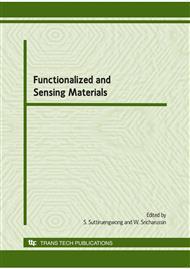[1]
J. Simon, H. P. Miller, R. Koch, and V. Miiller: Polymer Degradation and Stability Vol. 59 (1998), p.107.
Google Scholar
[2]
O. W. Mendieta-Taboada, P. J. A. Sobral, R. A. Carvalho and A. M. B. Q. Habitante: Food Hydrocolloids Vol. 22 (2008), p.1485.
DOI: 10.1016/j.foodhyd.2007.10.001
Google Scholar
[3]
A. Haque and E. R. Morris: Carbohydrate Polymer Vol. 22 (1993), p.161.
Google Scholar
[4]
I. K. Greener and O. Fennema: Journal of Food Science Vol. 54(6) (1989a), p.1393.
Google Scholar
[5]
I. K. Greener and O. Fennema: Journal of Food Science Vol. 54(6), (1989b), p.1400.
Google Scholar
[6]
S. L. Kamper and O. Fennema: Journal of Food Science Vol. 49 (1984), p.1478.
Google Scholar
[7]
J. J. Kester and O. Fennema: Journal of Food Science Vol. 54(6), (1989), p.1383.
Google Scholar
[8]
C. M. Koelsch and T. P. Labuza: Lebensmittel-Wissenschaft und-Technologie Vol. 25(5) (1992), p.404.
Google Scholar
[9]
D. C. Rico Pena and J. A. Torres: Journal of Food Process Engineering Vol. 13 (1990), p.125.
Google Scholar
[10]
H. J. Park and M. S. Chinnan: Journal of Food Process Engineering Vol. 25 (1995), p.497.
Google Scholar
[11]
F. F. Chen, in: Introduction to Plasma Physics, Springer (1984).
Google Scholar
[12]
N. Inagaki, in: Plasma-Surface Modification and Plasma Polymerization. Technomic, Lancaster, PA (1995).
Google Scholar
[13]
P. Chaivan, N. Pasaja, D. Boonyawan, P. Suanpoot and T. Vilaithong: Surface & Coatings Technology Vol. 193 (2005), p.356.
DOI: 10.1016/j.surfcoat.2004.08.144
Google Scholar
[14]
P. Suanput, K. Kueseng, S. Ortmann, R. Kaufmann, C. Umongno, P. Nimmanpipug, D. Boonyawan and T. Vilaithong: Surface & Coatings Technology Vol. 20 (2)(2008), p.5543.
DOI: 10.1016/j.surfcoat.2008.06.086
Google Scholar
[15]
S. K Hodak, T. Supasai, B. Paosawatyanyong, Kamlangkla, and V. Pavarajarn: Applied Surface Science Vol. 254 (2) (2008), p.4744.
DOI: 10.1016/j.apsusc.2008.01.110
Google Scholar
[16]
A. Tezcaner, K. Bugra, and V. Hasırcı: Biomaterials Vol. 24 (2003), p.4573.
Google Scholar
[17]
Z. Ding, J. Chena, S. Gao, J. Chang, J. Zhang, and E.T. Kang: Biomaterials Vol. 25 (2004), p.1059.
Google Scholar
[18]
G.H. Ryu, W. S. Yang, H. W. Roh, I. S. Lee, J. K. Kim, G. H. Lee, D. H. Lee, B. J. Park, M. S. Lee, and J. C Park: Surface & Coatings Technology Vol. 193 (2005), p.60.
DOI: 10.1016/j.surfcoat.2004.07.062
Google Scholar
[19]
M.T. Khorasani, H. Mirzadeh, and S. Irani: Radiation Physics and Chemistry Vol. 77 (2008), p.280.
Google Scholar
[20]
R.Y. Korotkov, T. Goff, and P. Ricou: Surface & Coatings Technology Vol. 201(2007), p.7207.
Google Scholar
[21]
P. Rachtanapun: Chiang Mai Journal of Science Vol. 34(2) (2007), p.1.
Google Scholar
[22]
S. Thawornwiriyanan, T. Jinkarn, A. Sane, P. Rachtanapun, and D. Boonyawan: Journal of Metals, Materials and Minerals Vol. 18 (2) (2008), p.153.
Google Scholar
[23]
T. P. Labuza and B. Altunakar: Water activity prediction and moisture sorption isotherms. In: Water activity in foods fundamentals and applications (Barbosa-Canovas G. V., Fontana, Jr. A. J., Schmidt, S.J. and Labuza, T.P. eds. ), Blackwell Publishing, Iowa, (2007).
DOI: 10.1002/9781118765982.ch7
Google Scholar
[24]
P. Rachtanapun and W. Tongdeesoontorn: Asian Journal of Food and Agro-Industry (In revision, 2009).
Google Scholar
[25]
W. Tongdeesoontorn, L. J. Mauer, S. Wongruong and P. Rachtanapun: Asian Journal of Food and AgroIndustry (In revision, 2009).
Google Scholar
[26]
M. Vargas, A. Albors, A. Chiralt and C. Gonzalez-Martınez: Food Hydrocolloids Vol. 19 (2) (2008), p.289.
Google Scholar
[27]
M. F. Cervera, M. Karjalainen, S. Airaksinen, J. Rantanenb, K. Krogarsb, J. Heina¨ma¨kib, A. I. Colartea, and J. Yliruusib: European Journal of Pharmaceutics and Biopharmaceutics, Vol. 58 (2004), p.69.
Google Scholar


